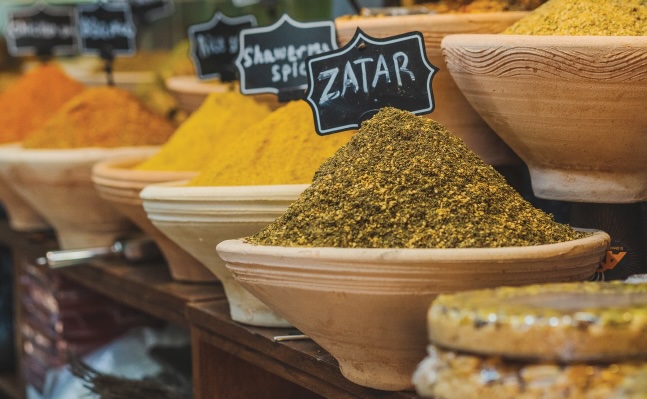Let’s talk about a Roti journey.
Close your eyes and open your mind and taste buds as we explore foods and traditions that date back millennia.
The Levant is where people transported themselves and their cooking and spices from Europe, Asia, Africa and the Middle East and found their melting place among the olive trees, desserts, mountains and in the valleys.
Here we can visit the souks or bazaars that are plentiful in the Levant. The grocery store up the block in Istanbul or Cairo or Beirut will do as well.
Enter these hundreds of years old buildings or brand-new markets, and you find rows of stalls and food counters and beautifully adorned barrels.
These are the ingredients that distinguish the food of the Levant.
Za’atar Spice:
If there is one smell and taste that defines the region’s history, it is Za’Tar. The hyssop leaf is at its origin, mixed with a medley of oregano, toasted sesame seeds, marjoram, sumac, sage or thyme that is warm and slightly pungent.
Fenugreek Spice:
A staple in Yemenite cuisine with origins in India, fenugreek has a bitterness that helps cut through the richness of other foods. It offers a unique texture that lends sheen and body to dishes.
Turmeric Spice:
Dried turmeric’s sunny hue and dusky, earthy essence flavors soups and dishes to deepen both the color and the tastes of food. It is a flowering plant in the ginger family. It is also the primary ingredient to many curry powders. India’s proximity to many Middle Eastern languages brought an immense amount of sharing of tastes.
Sumac Spice:
Ground from the beautiful fuchsia-hued berry of the same name, sumac has a tanginess reminiscent of sour citrus and is indispensable to Levantine cuisine. It is used in soups, kebabs and a colorful flourish on dips and spreads.
Sesame Seeds or Nigella Seeds:
Traditionally used to top many breads. Sesame seeds have a mild, sweet, and nutty flavor and a satisfying crunch when eaten whole. They are often baked or toasted to bring out a stronger almond-like flavor and aroma and make the seeds more evident in dishes.
The sesame seeds are found inside the fruit of a sesame plant. It is an ancient crop that appears in religious texts and fables.
Cinnamon Spice:
Cinnamon is a spice from the inner bark of several tree species. It is used as an aromatic condiment and flavoring additive for sweet and savory dishes. It has a woody and citrusy note.
Salts:
An essential ingredient in all Levant cooking. It is typically a coarse, edible salt, such as kosher which is sodium chloride. It is usually generously used to bring out the full natural flavor of food.
Orange Blossom and Rose Water:
These fragrant waters add floral aroma and flavor to desserts and drinks. They are made from steeping petals and rinds in water. Some chefs in the region prefer to make their sticky deserts, such as baklava, with rose water because it is lighter than honey.
Pomegranate Molasses:
Made from pure pomegranate juice, the molasses has become the “secret ingredient” that the Levant has long known. It is drizzled over or poured in a variety of savory dishes. It is sweet, tangy and earthy.
Tahini:
It is a creamy paste from sesame seeds and used extensively in beloved dips like hummus and baba ganoush (ground eggplant).
Unfiltered Extra-Virgin Olive Oil:
It’s nutty and rich. Full of vibrant flavors made from the first cold pressing of the olives. You’ll encounter great debates about not only what country produces the best olive oil, but what village and what farm are the best sources of this miracle ingredient. Color also matters. Some prefer darker shades of the oil, saying it provides more taste.
Labneh:
Labneh is a soft Middle Eastern cheese made from strained yogurt. It’s thick, creamy, tangy and rich. It is a common addition to mezze platters, where it is served as a dip with olive oil and spices.
Shatta:
Shatta is a chili paste that is very popular in Levant cuisine. It is hot and spicy and usually served with hummus, falafel, salads, foul sandwiches and poultry and meat. You name it and you can serve Shatta on it!
